29 Popular North American Hot Dogs To Try On Your Adventures
Hot dogs have become a beloved culinary icon that captures the essence of casual dining and street food culture.
These versatile sausages represent more than just a quick meal - they embody regional traditions and personal preferences.
North American hot dogs carry deep cultural significance beyond their simple ingredients.
Passionate food enthusiasts appreciate the complex flavor profiles and diverse preparation methods that transform these handheld favorites.
Regional variations showcase incredible creativity and local pride in crafting unique interpretations.
Chefs and home cooks alike experiment with unexpected toppings and unconventional techniques to elevate this classic comfort food.
Each hot dog tells a story of community, creativity, and culinary innovation.
Below are 29 popular North American hot dogs that will tantalize your taste buds:
Popular North American Hot Dogs That Go Beyond the Basics
Hot dogs are an American icon, but there’s so much more than ketchup and mustard. Explore regional favorites topped with everything from chili to pickles and tangy slaw.
Maxwell Street Polish
Maxwell Street Polish sandwiches epitomize Chicago street food culture with their sizzling Polish sausage origins rooted in immigrant innovation.
Macedonian immigrant Jimmy Stefanovic pioneered this iconic dish in 1943 at his hot dog stand in Chicago's bustling Maxwell Street market district.
Grilled or fried Polish sausages nestle inside soft buns, crowned with caramelized grilled onions and tangy yellow mustard.
Spicy pickled green sport peppers add an optional zesty kick for adventurous eaters.
Street vendors throughout Chicago have embraced this simple yet flavorful sandwich since its creation.
Jim's Original restaurant continues serving the sandwich that sparked a local culinary tradition.
Workers and hungry city dwellers still flock to street stands for this quick, satisfying meal.
Chicago's street food legacy lives on through this hearty sandwich that blends immigrant creativity with urban appetite.
Michigan Hot Dog
Michigan hot dogs burst with regional street food flavor from New York State and Quebec, featuring a steamed hot dog nestled in a long soft roll and smothered in signature thick, chunky Michigan sauce.
Regional vendors craft this savory specialty with a meaty tomato-based sauce blending vinegar, brown sugar, and cabbage over a natural-casing sausage.
Chopped onions and optional yellow mustard complete the messy, satisfying street snack.
Interestingly, despite its name, Michigan has no connection to this beloved regional dish.
Sauce preparation varies between local establishments, with some recipes closely guarded secrets passed through generations.
Street food enthusiasts seek out these hearty hot dogs at roadside stands and small restaurants.
Authentic versions showcase a specific steaming technique for both roll and sausage.
Chicago-Style Hot Dog
Chicago-style hot dogs emerged as an affordable street food during the Great Depression, revolutionizing fast meals with their complex flavor profile.
Street cart vendors created this iconic sandwich by selling Vienna beef hot dogs in steamed poppyseed buns for just a nickel.
Loaded with a distinctive mix of toppings, these hot dogs featured bright green relish, yellow mustard, fresh diced onions, red tomato slices, kosher pickles, and pickled peppers sprinkled with celery salt.
Customers quickly fell in love with the unique combination of contrasting textures and temperatures.
Each hot dog balanced crisp and soft elements with sharp and smooth flavors.
Vendors crafted an affordable, satisfying meal that became a culinary symbol of Chicago.
The hot dog's popularity soared as its innovative ingredients created an unforgettable street food experience.
Generations of locals and visitors continued to embrace this simple yet complex sandwich as a beloved city tradition.
Coney Dog
Coney dogs represent a classic Michigan street food featuring a beef hot dog smothered in unique all-meat chili, yellow mustard, and diced white onions nestled in a warm steamed bun.
Greek and Macedonian immigrants likely developed this iconic dish in Detroit during the early 1900s.
Three Michigan restaurants - American Coney Island, Lafayette Coney Island, and Todoroff's Original Coney Island - claim original creation rights.
Detroit became the primary birthplace of this beloved regional specialty after immigrants potentially passed through New York's Coney Island.
Restaurant founders transformed simple hot dogs into a signature regional meal.
Workers and families quickly embraced the affordable, flavorful street food.
Restaurants continue serving this beloved Michigan tradition since 1917.
Polish Boy
Polish boy dominates Cleveland's street food scene as a hearty kielbasa sandwich loaded with crispy fries, tangy coleslaw, and barbecue sauce inside a soft bun.
Virgil Whitmore pioneered this iconic creation in the 1940s by combining smoked beef sausage with readily available ingredients at his restaurant.
Cleveland locals and visitors alike celebrate this unique street food that blends Polish sausage traditions with American sandwich culture.
Pulled pork sometimes appears as a modern twist to the original recipe.
Barbecue sauce adds a signature kick that elevates the sandwich's flavor profile.
Kielbasa remains the centerpiece of this regional specialty.
Restaurants across Cleveland continue to serve this beloved street food with pride.
Cheese Coney Hot Dog
Cheese Coneys reign supreme as Cincinnati's iconic street food featuring a perfectly steamed bun loaded with spiced chili-covered sausage and mountains of grated cheddar cheese.
These regional hot dogs originate from Cincinnati's culinary traditions, blending German and Greek immigrant influences.
Chili parlors across the city specialize in crafting these flavor-packed sandwiches with unique chocolate and cinnamon-infused meat sauce.
Chopped fresh onions and optional mustard or hot sauce add extra zest to the signature dish.
Served hot and messy, Cheese Coneys represent more than just a quick meal.
Sausage links nestled in soft buns create a hearty handheld experience.
Regional pride and comfort define this beloved Cincinnati street food that continues to satisfy hungry locals and visitors alike.
Cheese Dog
Cheese dogs showcase American street food creativity by blending melted cheese with classic hot dog varieties through multiple preparation styles.
Hot dog sausages absorb cheese directly into their meat or receive cheese toppings across their surface, creating irresistible flavor combinations.
Cheddar cheese remains the most popular cheese selection, offering sharp tangy notes that complement the salty meat perfectly.
Buns serve as the primary vessel for these cheesy treats, though alternative breads like baguettes or toasted white bread occasionally appear.
Cheese-infused sausages emerge from regional culinary traditions across different United States communities.
Melting techniques vary from simple sprinkled shredding to elaborate cheese sauce applications.
Regional preferences determine specific cheese and hot dog ingredient combinations.
Street vendors and casual restaurants frequently feature these portable, satisfying snacks for quick meals.
Chili Dog
Chili dogs reign supreme as a beloved American street food featuring a sausage nestled in a soft bun and generously smothered in spicy chili sauce.
Originating from disputed locations like Texas and Los Angeles, these savory handheld meals became popular at street stands and sports venues nationwide.
Toppings vary widely, with onions, cheese, and mustard frequently adorning the classic dish.
Diners appreciate the simple yet satisfying combination of grilled sausage and zesty chili sauce.
Affordable and quick to prepare, chili dogs have been a staple of casual American dining for decades.
Street vendors and small eateries continue to serve these iconic sandwiches to hungry customers.
Regional variations showcase different styles of chili and sausage preparation.
Compact and flavorful, chili dogs remain a go-to comfort food for many Americans.
Carolina-Style Hot Dog
Carolina-style hot dogs feature a unique blend of toppings that transform simple sausages into a regional culinary signature.
Sweet, tangy coleslaw creates a crunchy contrast against spicy chili and sharp mustard layered on a soft bread roll.
Regional variations across North and South Carolina determine specific ingredient combinations and topping styles.
Mustard often serves as an optional or replacement condiment for slaw.
Hamburger preparations have now adopted similar topping techniques.
Street vendors and local restaurants frequently showcase these distinctive hot dogs.
Regional pride connects communities through this beloved street food tradition.
Southern food culture celebrates these hot dogs as more than just a quick meal.
Slaw Dog
Slaw dogs revolutionize traditional hot dogs with West Virginia's signature street food featuring a grilled hot dog smothered in tangy coleslaw and chili sauce.
Originating in Charleston during the 1920s or 1930s at Stopette Drive-in, these messy handheld meals quickly became a regional culinary staple.
Authentic versions strictly include a steamed hot dog nestled in soft bread topped with hearty chili and creamy coleslaw.
Locals serve these iconic sandwiches in disposable paper boats or styrofoam containers for easy eating.
Strict regional customs discourage additional toppings like ketchup, sauerkraut, or pickles.
West Virginians consider slaw dogs a point of cultural pride and deeply rooted tradition.
Generations have enjoyed this simple yet flavorful street food that represents mountain state cuisine.
Regional restaurants and roadside stands continue serving these beloved hot dogs to hungry locals and curious travelers.
Montreal Hot Dog
Montreal hot dogs represent a beloved Canadian street food combining steamed or toasted sausages with classic toppings in a soft bun.
Steamies remain the most popular version, featuring juicy frankfurters nestled in warm bread and generously covered with chopped onions and creamy coleslaw.
Mustard and tangy relish add extra flavor complexity to this street-style sandwich.
Toasties offer a crispier alternative, slightly pricier but equally satisfying for hungry diners.
Canadian food culture celebrates these simple yet delicious handheld meals as quick, affordable lunch options.
Street vendors and small restaurants across Montreal serve these regional specialties with regional pride.
Regional variations might include different sausage types or unique condiment combinations, reflecting local tastes and culinary traditions.
Danger Dog
Danger dogs represent a bold Mexican street food sensation featuring a crispy bacon-wrapped sausage nestled in a soft bolillo roll.
Street vendors across Mexico grill these sausages until perfectly charred and crackling with smoky flavor.
Hungry patrons devour the hot dog loaded with zesty toppings like spicy jalapeño salsa, fresh diced tomatoes, and sharp onions.
Creamy mayonnaise and tangy mustard add extra layers of flavor to this handheld meal.
Each danger dog combines smoky, spicy, and savory elements in one irresistible bite.
Regional variations include different sausage types and unique condiment combinations.
Mexicans celebrate this quick, affordable street snack as a beloved urban culinary tradition.
Bacon creates a crisp, salty exterior that elevates the entire street food experience.
Bagel Dog
Bagel dogs merge classic hot dog excitement with chewy bagel texture, creating a portable street food sensation originating in major American cities like New York and Chicago.
New York street vendors pioneered this handheld snack by wrapping frankfurter sausages inside soft, dense bagel dough for maximum flavor and convenience.
Poppy seeds often garnish the exterior, adding crunch and visual appeal to the compact meal.
Milan R. reportedly invented the treat in 1980, transforming traditional hot dog presentations.
Street food enthusiasts quickly embraced this innovative combination of bread and meat.
Small variations include adding cheese, onions, or garlic to enhance the basic recipe.
Baking ensures a crispy exterior and warm, satisfying interior.
Bagel dogs remain a beloved quick bite for urban diners seeking nostalgic comfort food.
Corn Dog
Corn dogs are deep-fried hot dogs coated in sweet cornmeal batter served on a convenient wooden stick.
Neil Fletcher first popularized this iconic American snack at the Texas State Fair in 1942, quickly becoming a nationwide favorite.
Vendors at state fairs, carnivals, sports arenas, and food courts embraced the portable treat as a quick meal option.
Regional variations emerged in countries like Argentina, Australia, New Zealand, and Japan, expanding its global appeal.
Fans typically enjoy corn dogs with classic condiments such as yellow mustard, pickles, sauerkraut, or mayonnaise.
Some versions feature unique batter recipes or additional toppings for extra flavor.
Minnesota State Fair claims an earlier 1941 invention called the Pronto Pup, challenging Fletcher's origin story.
Corn dogs remain a beloved street food and carnival staple across the United States.
Seattle Dog
Seattle dogs combine grilled street sausages with unexpected Pacific Northwest flavors, featuring a toasted bun smeared with rich cream cheese and topped with caramelized onions.
Regional variations allow creative additions like barbecue sauce, crispy bacon, pickled vegetables, and fresh pico de gallo.
Seattle street vendors popularized this unique hot dog style during outdoor events and late-night street food scenes.
Sausage selections range from traditional beef to spicy bratwurst or Polish-style links.
Generous grilled onions provide sweet, smoky depth to the sandwich.
Cream cheese creates a smooth, tangy base that distinguishes this regional specialty.
Mustard and additional condiments enhance the complex flavor profile.
Street food culture in Seattle embraces this inventive hot dog as a signature quick meal.
Reuben Dog
Reuben dogs merge classic sandwich flavors with hot dog convenience, creating a mouthwatering street food fusion originating in New York City.
Juicy hot dogs get pan-fried in butter and nestled into split buns for maximum texture and taste.
Swiss cheese melts perfectly over the sausage, adding rich creamy notes to each bite.
Tangy sauerkraut provides a sharp, fermented crunch that balances the meat's richness.
Thousand Island or Russian dressing drizzled on top adds a zesty, creamy finish to this compact meal.
German and Jewish culinary influences shape the dog's unique ingredient combination.
Street vendors and casual restaurants frequently feature this indulgent twist on traditional hot dogs.
American comfort food fans love this compact, flavor-packed street treat that transforms two classic dishes into one satisfying experience.
Fenway Frank
Fenway franks embody Boston's baseball culinary heritage, serving as an iconic hot dog synonymous with Fenway Park's rich sporting culture since 1912.
Stadium vendors have long sold these signature grilled beef frankfurters nestled in soft New England-style rolls.
Baseball fans consider these hot dogs a must-have ballpark treat, traditionally prepared by steaming and grilling high-quality frankfurters.
Standard preparation involves boiling Nathan's Famous hot dogs before grilling them to achieve a perfect charred exterior.
Toppings typically include mustard, relish, and sometimes onions, reflecting classic American street food traditions.
Massachusetts sports enthusiasts have embraced these franks as more than just a snack, but a nostalgic game-day experience.
Red Sox supporters consider these hot dogs an essential part of their baseball ritual, connecting generations through a simple yet beloved stadium cuisine.
Historic Fenway Park continues to serve these beloved frankfurters, maintaining a delicious culinary tradition that spans over a century.
Massachusetts-Style Hot Dog
Boston hot dogs stand out as a unique regional specialty featuring steamed frankfurters nestled in specially cut side-split buns.
Massachusetts residents prefer these hot dogs served alongside traditional baked beans, creating a classic local combination.
Thin buns specifically designed for these hot dogs ensure the meat remains the primary focus of the meal.
Regional vendors carefully steam the frankfurters to maintain a juicy, tender texture that distinguishes them from grilled alternatives.
Side-cut buns allow the hot dog to sit perfectly inside without overwhelming the meat.
Baked beans complement the hot dog with a rich, savory backdrop that enhances the overall dining experience.
Massachusetts embraces this simple yet satisfying street food as a beloved culinary tradition.
Steaming techniques and specific bun preparation make Boston hot dogs a distinctive regional variant of this popular American dish.
Dodger Dog
Dodger dogs epitomize baseball stadium cuisine as an iconic Los Angeles Dodgers signature food served primarily at Dodger Stadium since the 1960s.
Farmer John produces these famous hot dogs, selling over 3 million annually to passionate baseball fans.
Grilled or steamed, these classic frankfurters come wrapped in a soft bun and represent more than just a meal.
Stadium visitors consider them a cultural symbol deeply connected to baseball experience.
Fans eagerly consume these simple yet beloved sausages during games as a traditional snack.
Dodger dogs have become synonymous with Dodgers baseball, transcending their basic food status.
Manufactured locally in California, these hot dogs carry deep roots in Southern California sports culture.
Millions of spectators enjoy these signature frankfurters as an essential part of their ballpark experience.
Reindeer Dog
Reindeer dogs represent a unique Alaskan street food featuring sausages crafted from caribou, pork, and beef.
Originating in Alaska, these hot dogs combine wild game meat with traditional sausage ingredients for a distinctive flavor profile.
Grilled and split sausages nestle inside soft steamed buns, creating a hearty handheld meal.
Coca-Cola-deglazed onions add a sweet and tangy dimension to the hot dog's taste.
Mustard and cream cheese provide additional layers of flavor and richness.
Ketchup and relish sometimes complement the complex taste combinations.
Street vendors and local restaurants across Alaska frequently serve these regional specialty hot dogs.
Meat enthusiasts and travelers seek out reindeer dogs as a memorable culinary experience that captures Alaska's rugged food culture.
Half-Smoke Hot Dog
Half-smoke hot dogs are Washington D.C.'s signature street food featuring a thick, coarsely ground beef and pork sausage with a spicy red pepper kick.
Local street vendors grill these unique sausages, which are slightly wider and more robust than traditional hot dogs.
Street food enthusiasts recognize half-smokes by their distinctive spiciness and meaty texture.
Sausage makers typically blend equal parts beef and pork for maximum flavor.
Grilling brings out the sausage's smoky essence and creates a satisfying char.
Chili, mustard, and diced onions are classic toppings that complement the spicy meat.
Half-smokes originated in Washington D.C. and remain a beloved regional specialty.
Numerous theories explain the name's origin, from smoking techniques to preparation methods.
Ripper
Rippers are deep-fried hot dogs from New Jersey that burst open during cooking, creating a crispy, unique texture that sets them apart from traditional frankfurters.
Rutt's Hut in Clifton pioneered this distinctive preparation method, transforming ordinary hot dogs into a regional culinary sensation.
Diners can choose between different levels of doneness, including Wellers and Cremators, which offer progressively darker and crispier results.
Restaurant patrons often enjoy these spicy sausages with signature homemade mustard relish blending onions, carrots, and cabbage.
Rippers gained national attention after appearing on the Travel Channel's Hot Dog Heaven special.
Their crispy exterior and juicy interior make them a beloved New Jersey street food staple.
Served alongside golden onion rings, these hot dogs represent a unique twist on classic American fare.
Meat lovers appreciate the dramatic burst and intense flavor of these deep-fried delicacies.
Texas Tommy
Texas Tommy hot dogs merge Pennsylvania's bold street food legacy with indulgent bacon and cheese combinations.
Originating in Philadelphia, these loaded hot dogs feature split and grilled sausages wrapped in crispy bacon strips and generously covered in melted cheese.
Bacon envelops the hot dog before grilling, creating a decadent street-style meal that packs intense flavor.
Street vendors first popularized this hearty sandwich in mid-20th century urban neighborhoods.
Mexican-style Tijuana dogs likely drew inspiration from this regional specialty.
Bacon adds a smoky crunch that elevates the classic hot dog experience.
Regional pride runs deep in this simple yet satisfying street food.
Baltimore-Style Hot Dog
Kosher bologna dogs are a mouthwatering street food featuring a juicy kosher beef sausage fried alongside bologna slices until golden and crispy.
Bologna wraps the sausage completely before nestling into a soft bread bun.
Dill pickle spears add a sharp crunch to the sandwich's profile.
Yellow mustard delivers a tangy kick across the top of the loaded dog.
Urban street vendors in regions like New York and New Jersey popularized this hearty sandwich.
Working-class neighborhoods first embraced this affordable protein-packed meal.
Lunch counters and casual eateries continue serving these classic regional sandwiches.
Regional pride connects these dogs to street food culture and quick midday meals.
Dixie Dog
Slaw dogs represent a signature West Virginia street food featuring split hot dogs smothered in chili and creamy coleslaw.
West Virginia restaurants popularized this unique sandwich across the Appalachian region during mid-20th century food culture.
Regional diners typically serve these hot dogs on soft white rolls with mustard-based chili sauce as a standard topping.
Huntington claims origin credits for this distinctive hot dog style that combines meaty sausage with tangy coleslaw.
Local restaurants often compete to create the most flavorful chili and creamiest slaw mix.
Hot dog enthusiasts appreciate the messy yet satisfying combination of textures and flavors.
Regional variations might include additional condiments like onions or different chili styles.
Slaw dogs remain a beloved quick meal throughout West Virginia and neighboring mountain states.
Italian Hot Dog
Italian hot dogs originate from Newark, New Jersey, featuring a unique street food experience with oversized pizza bread loaves sliced into quarters and generously filled with deep-fried sausages.
Large circular bread with a central hole serves as the base for this hearty sandwich, creating a distinctive vessel for its savory ingredients.
Crispy potatoes nestled inside provide a satisfying crunch against the tender, juicy sausage links.
Sweet caramelized onions and roasted peppers complement the meat's rich flavor profile.
Fried ingredients blend together, offering a bold and indulgent taste sensation.
Street vendors and local restaurants have perfected this iconic New Jersey creation over decades.
Immigrant culinary traditions shine through this inventive sandwich design.
Idaho Hot Dog
Idaho hot dogs fuse comfort food with rustic potato creativity by baking a skinless hot dog inside a hollowed-out Idaho potato.
Local restaurants and home cooks craft this unique regional snack by carefully inserting a frankfurter into a potato's center before baking to golden perfection.
Crispy potato skin provides a sturdy vessel for the juicy hot dog nestled within its starchy embrace.
Chives, crisp bacon bits, and a dollop of tangy sour cream crown this hearty potato-wrapped treat.
Street vendors and small-town diners across Idaho popularized this inventive twist on classic hot dogs.
Potato-loving residents consider this dish a playful homage to their state's most famous agricultural product.
Western states like Idaho embrace such innovative culinary combinations that transform simple ingredients into memorable meals.
Travelers seeking authentic regional street food often seek out this distinctive potato-hot dog hybrid.
Puka Dog
Puka dogs feature a unique Hawaiian street food design with a distinctive bread-pierced preparation method that sets them apart from standard hot dogs.
Hawaiian vendors create these signature sausages by using a special cylindrical roll with a hole baked directly through its center.
Hot dog sausages get inserted through this pre-made opening after being coated in signature tropical sauces and seasonings.
Local Hawaiian street vendors developed this innovative sandwich style on Kauai island during the 1990s.
Mustard, garlic sauce, and fruity relishes enhance the flavor profile of these distinctive hot dogs.
Tourists and locals alike enjoy puka dogs as a quick, portable meal that combines traditional Hawaiian ingredients with American street food traditions.
Sweet Hawaiian rolls provide a unique bread base for these handheld meals.
Soft Portuguese-style sausages complete the characteristic flavor and texture of this island specialty.
Francheezie
Francheezie is Chicago's indulgent street food masterpiece - a hefty hot dog split lengthwise and generously stuffed with melted cheese before being completely enveloped in crispy bacon and deep-fried to golden perfection.
Local diners and street vendors first created this decadent snack in mid-20th century Chicago as a hearty twist on standard hot dogs.
Bacon wraps the entire sausage in a salty, crisp exterior that adds extra crunch and flavor.
American, Cheddar, or Velveeta cheese oozes from inside the hot dog's center when bitten.
Greasy and rich, Francheezie delivers maximum flavor in every single bite.
Hot dog enthusiasts consider this dish a classic Chicago street food staple.
Restaurants across the city still serve this iconic sandwich today.
Midwest comfort food doesn't get more satisfying than this meaty, cheesy creation.
Which Toppings Are Most Popular on Hot Dogs Across North America?
Hot dogs across North America come with a wide range of toppings, but several classics stand out for their popularity and regional appeal:
Regional variations also introduce unique toppings, such as coleslaw, bacon, or specialty sauces, reflecting local tastes and traditions.

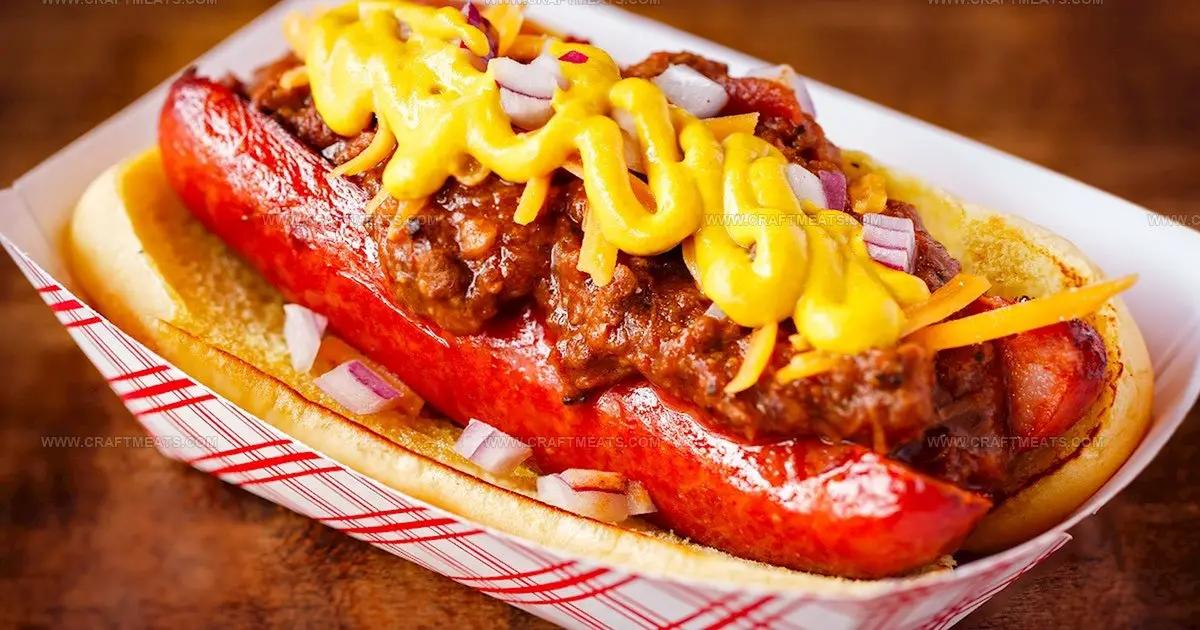
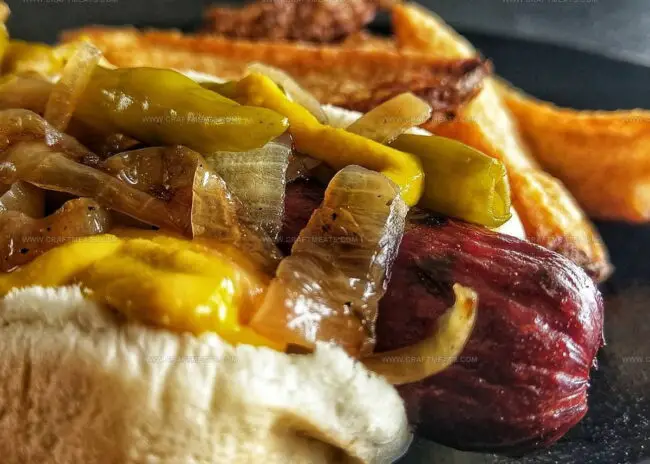
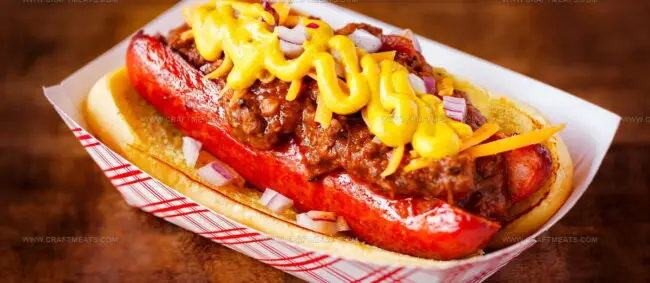
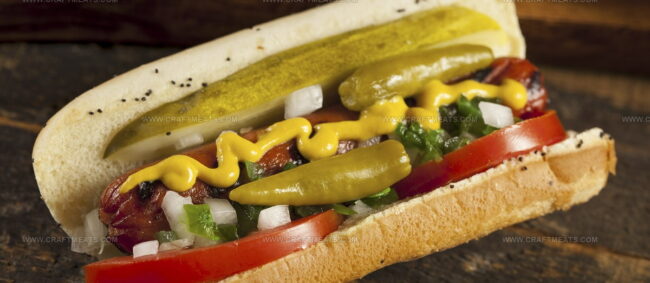

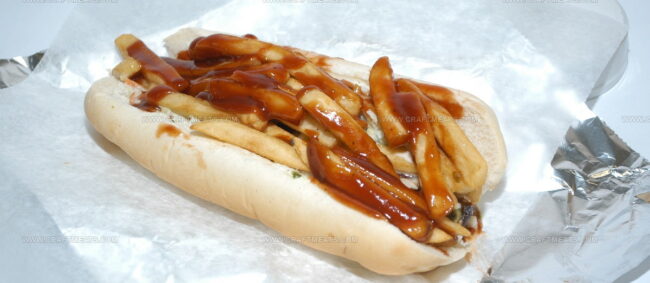

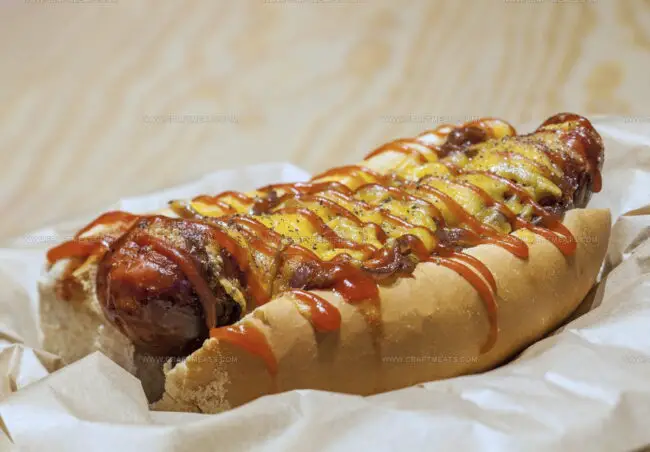
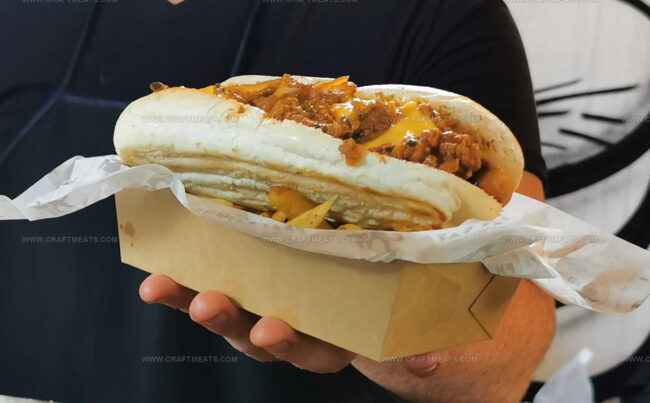
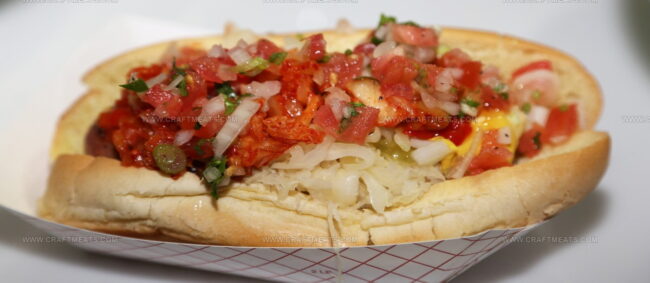
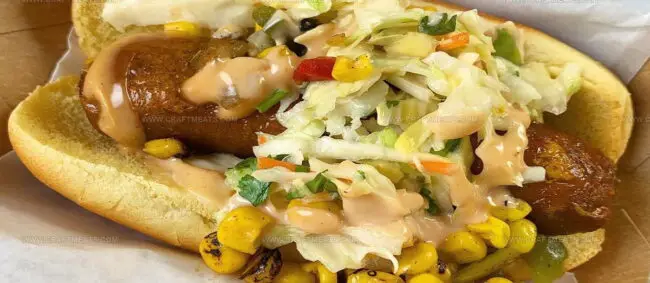
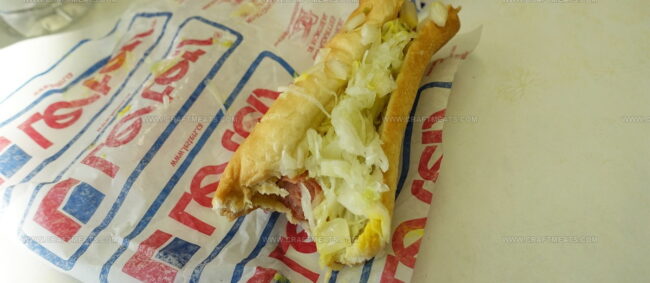
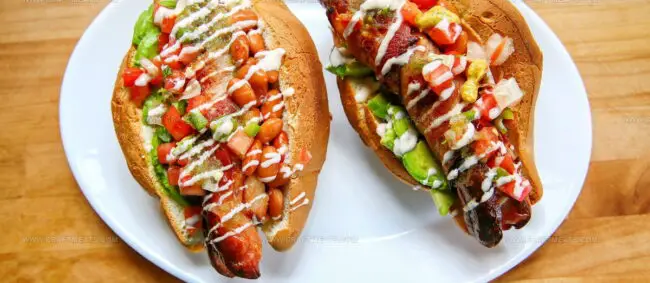







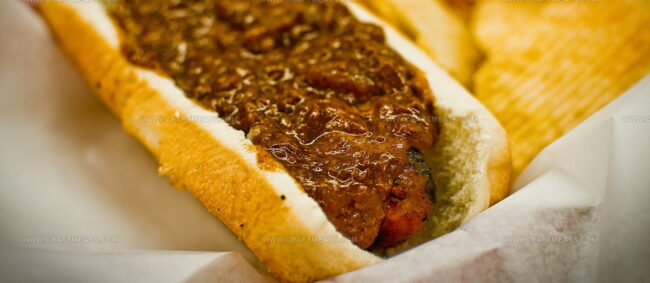



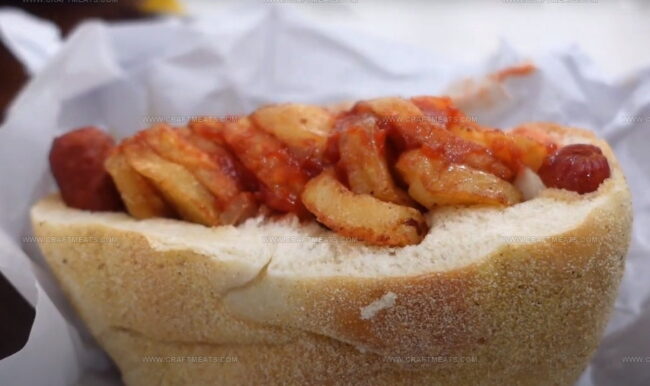


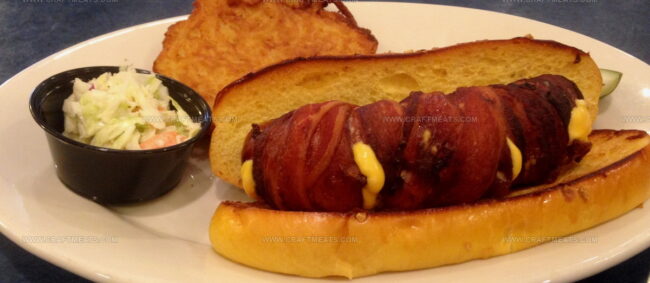

Isabella Rossi
Founder & Culinary Content Creator
Expertise
Recipe Development, Traditional Irish and European Cuisines, Food Styling and Photography, Culinary Education
Education
Dublin Institute of Technology (DIT) – School of Culinary Arts and Food Technology
Ballymaloe Cookery School
Liam is the voice behind many of Craft Meats’ most flavorful features. With roots in Dublin’s smoky barbecue scene and a culinary degree from the Dublin Institute of Technology, he brings time-tested cooking techniques to life.
His training at Ballymaloe Cookery School sharpened his farm-to-table approach, giving him a deep respect for every ingredient he writes about.
He’s not about overcomplicating the process, just helping you cook meat that’s worth talking about. When he’s not writing or grilling, he’s out foraging or nerding out on regional spice blends to add to his next recipe.